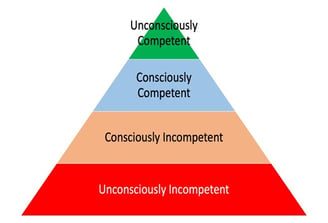Do you Really Know?
In, Episode 11, I explained how the Law of Diffusion of Innovation can be a barrier to manufacturing businesses adopting Industry 4.0. I'd like to share with you another barrier that I've experienced and it's important you know what it is and how to navigate it if you're to move forward as a progressive manufacturing business or solution provider.
Welcome to episode twelve of a fourteen-part series by John Broadbent from Realise Potential.
Back in the late 1990s, I attended what was for me to become a pivotal keynote. I remember it was presented by a guy called Glen Garner, if my memory serves me correctly, who at the time worked for Honeywell.
He undertook some research to look for a correlation between best practice and automation in manufacturing. Of course, linking best practice to automation would have been ideal for Honeywell!
However, he found that some of the best-automated businesses were actually the worst practice!
Why was this?
According to Wikipedia, the model known as The Four Levels of Teaching and developed in the late sixties, and early seventies, goes something like this, and we'll use driving a car as an example.
Imagine you're ten years old and you're with your dad who's driving the car. He's changing channels on the radio, talking with you, answering his phone, staring out the window, so to you driving a car is a piece of cake. At this stage, you don't know that you don't know how to drive.
One day, you get your Learner's permit, get behind the wheel and, under instruction start to learn to drive. Whoa, all the things I have to remember! The brakes, indicators, changing gears, watch where I'm going, check my speed, watch out for cars and pedestrians! I never knew driving was so difficult!
You now know that you don't know how to drive.
As you learn and practice more, you eventually get your provisional driver's licence. You now know you know how to drive, but you need to focus and pay really close attention to what you're doing and minimise distraction.
After a few years, you're just like your dad, listening to the radio, talking to passengers, or on your phone, and now you don't even have to think about driving. You're on autopilot. In fact, have you ever gotten in the car and been so preoccupied with thoughts that you've arrived at your destination and not remembered much about how you actually got there?
Scary, huh?
So, what's this got to do with manufacturing?
 This model applies to all facets of learning and can be thought of as a pyramid like this. At the bottom level, when we're the 10-year-old boy in the car, we're Unconsciously Incompetent; that is, we don't know that we don't know how to drive.
This model applies to all facets of learning and can be thought of as a pyramid like this. At the bottom level, when we're the 10-year-old boy in the car, we're Unconsciously Incompetent; that is, we don't know that we don't know how to drive.
The day we get behind the wheel, we then become Consciously Incompetent; that is, we now know we don't know how to drive.
When we get our full licence, we're now Consciously Competent, which means we still have to think about what we're doing.
Then finally, we become Unconsciously Competent, meaning we don't have to think about it anymore as driving is automatic.
The revelation for Honeywell was that they found all the best practice manufacturing businesses were unconsciously competent, irrespective of their level of automation.
They simply did what they did well, had all the processes, people and systems in place, and it all worked.
And here comes the clincher.
Glen noted that the worst practice companies were down in the bottom layer, that is, unconsciously incompetent.
My light bulb moment was when he stated that if ever you try to push a business as an external supplier or consultant through the barrier to the consciously incompetent layer, what you will meet is HOSTILITY!
Think about that for a moment.
By holding up a mirror to an organisation, to show that they don't know can create an environment where you're painting a cross-hair on yourself.
This was such a revelation for me that I came back to my business the following day, called in the team and explained the model. The 'Aha' moment led us to then segment our customer base and prospects into those four layers, and we discovered that those we'd had the best relationship and outcomes with were consciously incompetent. They'd recognised they didn't know, needed our help, and we delivered to solve their problems.
As for the unconsciously incompetent group, it explained why we'd wasted so much time with them kicking our tyres, so we gently and purposefully let them go and stopped investing any further time with them.
When it comes to Industry 4.0, the unconsciously incompetent will struggle, and probably try a few 'toe-in-the-water proof of concept' projects (which by the way, are destined to fail due to a lack of alignment and commitment at all levels, and they think they know it all anyway), and then most likely give up.
Only the consciously incompetent manufacturing businesses who know they don't know will reach out for help and they'll become the innovators and early adopters and claim that initial competitive advantage.
They'll then mature into the unconsciously competent group over time and lead the way.
In fact, that's what the 54 businesses in the World Economic Forum's Global Lighthouse Network or GLN are all about.
I hope this model provides you with as much revelation as it did me, so maybe take a look at your organisation and see if you can assess where you fit culturally in the model.
And if you're a solution provider, take a good look at your client base, segment them into the four layers and see where your focus should really be. Using this, you can avoid hostility and those headbanging "Why don't they just get it?" moments.
Until the next time, stay safe and well, and I'll see you in episode 13.
John Broadbent

Watch John's original LinkedIn video here.
.png?width=190&name=IPA%20Logo%20Transparent%20(Hi-Res).png)




